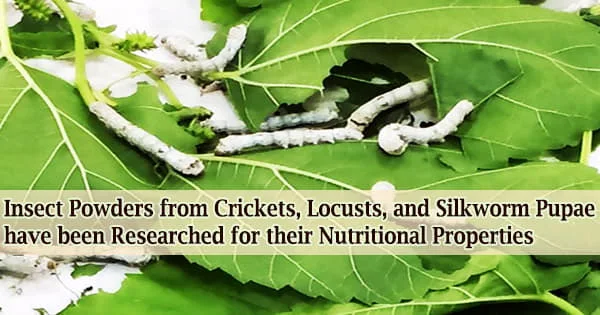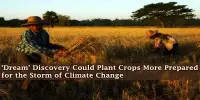Traditional livestock farming may become less sustainable as the human population expands to a predicted 10 billion by 2050 but the overall landmass remains constant.
Traditional animal husbandry has met human protein nutritional needs, but insects may one day serve as a viable alternative for direct human consumption.
Jacek Jaczynski, professor of food science and muscle food safety at West Virginia University’s Davis College of Agriculture, Natural Resources and Design, Yong-Lak Park, professor of entomology, and Kristen Matak, professor of animal and nutritional sciences, determined the nutritional and functional properties of protein for cricket, locust and silkworm pupae powders, therefore laying a foundation to develop efficient protein isolation techniques.
Their findings are published in LWT.
“We have a patent on a protein isolation procedure,” Jaczynski said. “We use our patented technique to isolate protein and then we also learn about properties of isolated protein and how it can be potentially used in food for human consumption.”
Protein is an essential component of every diet. Every cell in the body contains it. It aids in the formation and repair of cells and tissues in the body. Skin, muscle, bone, organs, hair, and nails are all made up of protein.
Protein is one of three macronutrients or nutrients that the body needs in greater quantities. Fat and carbs are the other macronutrients. Protein isolation, according to Jaczynski, is a procedure that allows for the purification and up-concentration of protein from numerous sources.
“For example, milk contains water, fat, carbohydrates, vitamins, minerals, and various proteins such as casein and whey,” Jaczynski said. “Whey protein can be selectively isolated by various isolation processes, which remove water, fat, carbohydrates, etcetera. This process results in whey protein isolate or purified and up-concentrated protein.”
Whey protein isolate is a typical food addition that results in foods with increased protein content, for example. Long strands of amino acids make up protein. In Jaczynski’s, Park’s, and Matak’s effort, they isolate protein from insects, such as muscle protein.
The global demand for sustainable sources of protein has created a shift from traditional sources like meat to other sources that were otherwise overlooked. Edible insects and insect flours are promising as meat alternatives because they are typically rich in protein and contain all of the essential amino acids.
Matak
According to Jaczynski and Matak, as the human population rises, there will be a demand for an alternative protein source.
“I think overall, we have a good handle on carbohydrates, but protein is always behind,” Jaczynski said. “That’s why we target protein from those alternative sources like insects to hopefully contribute to less hunger, malnutrition, and difficult societal issues.”
“The global demand for sustainable sources of protein has created a shift from traditional sources like meat to other sources that were otherwise overlooked,” Matak said. “Edible insects and insect flours are promising as meat alternatives because they are typically rich in protein and contain all of the essential amino acids.”
Researchers propose that the insects be ground into powder to make them more enticing to eat. This procedure is analogous to how people turn fat into flour in order to make it more appetizing.
Insect powders are basically dried and powdered insects, comparable to grain flours or plant-based powders.
According to Jaczynski, Park, and Matak, although insect powders are a straightforward and convenient processing approach for increasing shelf life, their original composition likely limits their applicability in food products, which could result in low customer acceptability.
Insect powders are presently accessible commercially and can be found in granola bars, tofu, and burgers, according to Park. The consumption of terrestrial insects is commonplace in most parts of the world.
In Western societies, eating insects, on the other hand, is frowned upon. Despite this, because they eat fresh plants and wood rather than carrion, most edible terrestrial insects appear to be cleaner than crabs, lobsters, and shrimp.
According to Jaczynski, 80 percent of the world’s population consumes insects, with Western civilizations accounting for the remaining 20%.
“It’s a minority that doesn’t consume insects,” Jaczynski said. “As the population grows, we’ll have to feed everyone. I don’t say insects will replace our farm animals, but it’s another alternative that seems more sustainable than what we currently do.”
Insect protein, for example, can be extracted considerably faster than beef from a cow or pig, and it also uses less land and water. Insects also have a short lifespan, reproduce quickly, and have simple habitat and nutrient requirements.
Insect harvesting takes 45 days on average, according to Jaczynski and Park, compared to four to 36 months for traditional farm animals.
A certain variety of grasshopper was even discovered to produce the identical actin and myosin proteins found in pigs and cows. Over 2,000 bug species have been identified as suitable for human consumption, but some species have been examined more extensively than others, according to Park.
“Mealworm and crickets are popular because they’re very easy to mass produce,” Park said. “So, when we produce insects as human food and animal feed, it should be very easy to mass produce, otherwise it does not justify the cost.”
People in some Asian countries may eat leftover silkworm pupae from a cocoon due of its high nutritional content, according to Park.
Jaczynski, Park, and Matak discovered that using pH-solubility-precipitation, protein can be successfully extracted from insects, resulting in isolates of good nutritional and functional quality.
Proteins dissolve in water in the same way that sugar and salt do. Protein solubility, on the other hand, is affected by the pH of the solution in which the protein is present.
“Depending on the pH of a protein solution, protein solubility can be turned on or off, sort of like a light switch, so that protein can dissolve or precipitate (no solubility),” Jaczynski said.
Solubility is the polar opposite of precipitation. According to Jaczynski, when protein dissolves in a solution, it visibly vanishes, exactly like sugar or salt, and when protein precipitates, it visually reappears.
“With insects, our point is to selectively extract those nutrients, like proteins and lipids,” Jaczynski said.
“Grains have been around for ages, and they were totally accepted by all populations,” Jaczynski continued. “Why don’t we use insects with the same kind of model on a high level as a source of nutrients? We have to find a way to extract and isolate high quality nutrients and develop prototypes that will jive well with our taste buds.”
Joined on this study was Emily Brogan, former Animal and Nutritional Sciences master’s student.
















